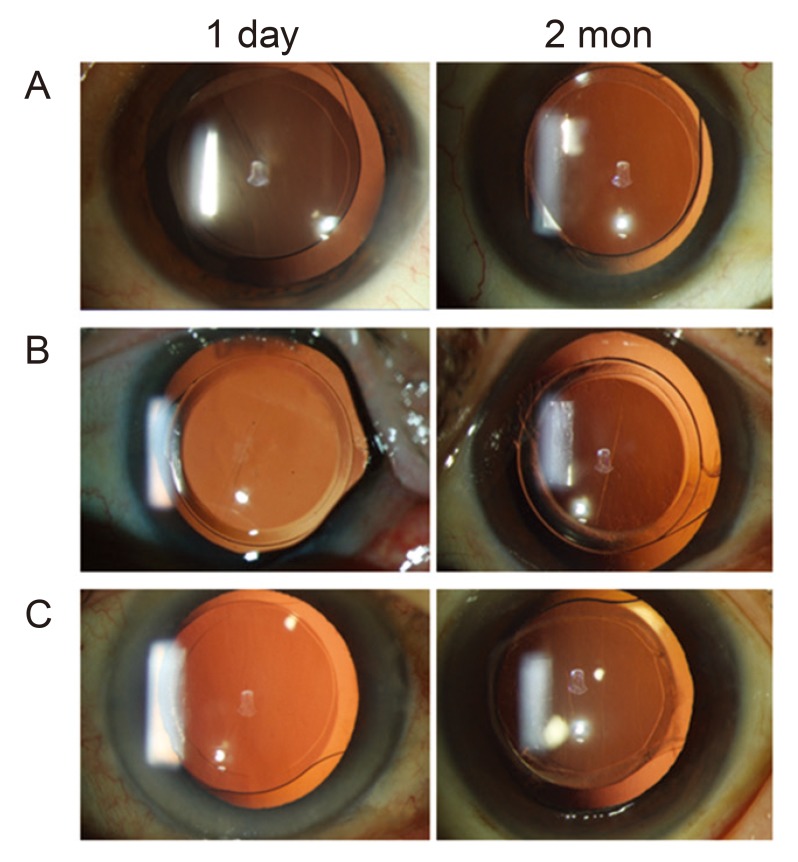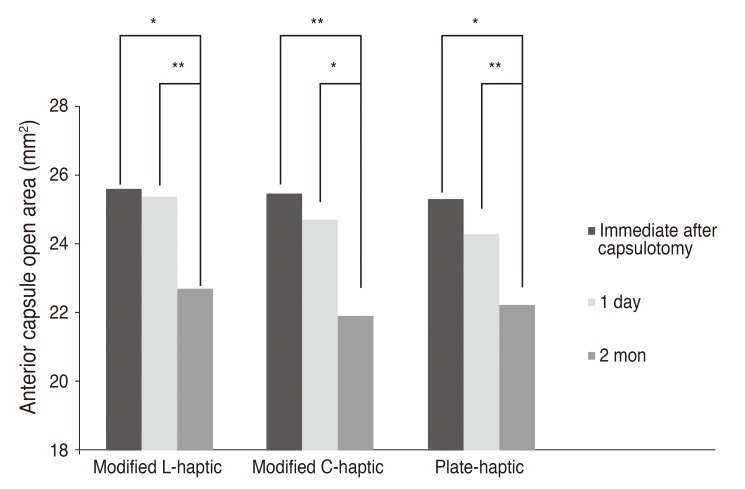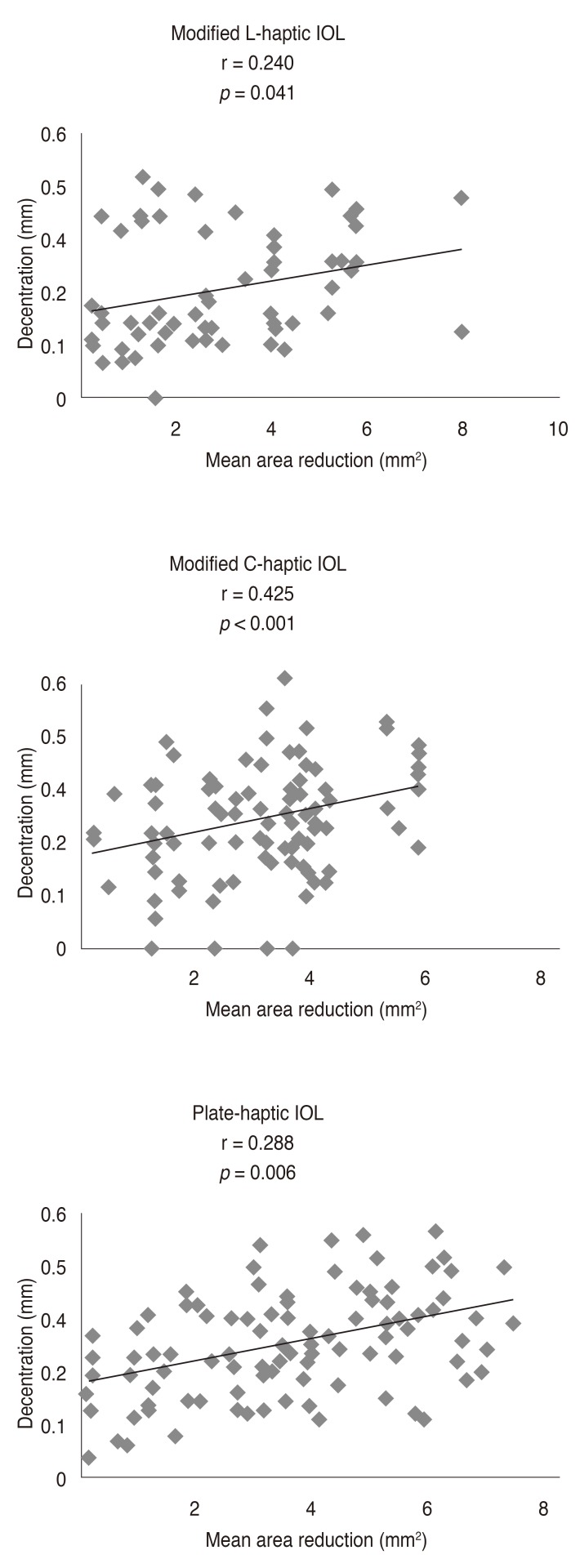Korean J Ophthalmol.
2017 Feb;31(1):32-38. 10.3341/kjo.2017.31.1.32.
Comparison of Anterior Capsule Stability Following Implantation of Three Single Piece Acrylic Intraocular Lenses with Different Haptic Design
- Affiliations
-
- 1Department of Ophthalmology and Visual Science, Seoul St. Mary's Hospital, College of Medicine, The Catholic University of Korea, Seoul, Korea. ckjoo@catholic.ac.kr
- 2Nune Eye Hospital, Seoul, Korea.
- 3Department of Ophthalmology and Visual Science, Yeouido St. Mary's Hospital, College of Medicine, The Catholic University of Korea, Seoul, Korea.
- 4Catholic Institute for Visual Science, College of Medicine, The Catholic University of Korea, Seoul, Korea.
- KMID: 2368676
- DOI: http://doi.org/10.3341/kjo.2017.31.1.32
Abstract
- PURPOSE
To compare the anterior capsule contraction and intraocular lens (IOL) decentration among three types of IOL to determine the influence of haptic design on anterior capsule stability.
METHODS
One hundred fifty patients were enrolled in this prospective, randomized study and 260 eyes underwent implantation of one of the following IOLs: modified L-haptic IOL (n = 74), modified C-haptic IOL (n = 97), or a plate-haptic IOL (n = 89). The area of the anterior capsule opening, IOL decentration, and capsule overlap were measured using retroillumination photospot 1 day and 2 months after cataract surgery.
RESULTS
The area of capsule opening at postoperative day 1 was significantly different between the three IOLs (p < 0.01). All IOLs showed reduction of the anterior capsule opening from 1 day to 2 months after surgery, and greater reduction was shown in the modified C-haptic IOL (p < 0.001). At postoperative month 2, IOL decentration was significantly different between the IOLs and showed a positive correlation with the mean area reduction during month 2.
CONCLUSIONS
The degree of anterior capsule contraction and IOL decentration in modified L-haptic IOLs were less than those in modified C-haptic IOLs and comparable to those in plate-haptic IOLs.
Keyword
Figure
Reference
-
1. Hara T, Azuma N, Chiba K, et al. Anterior capsular opacification after endocapsular cataract surgery. Ophthalmic Surg. 1992; 23:94–98. PMID: 1549302.
Article2. Jin-Poi T, Shatriah I, Khairy-Shamel ST, Zunaina E. Rapid anterior capsular contraction after phacoemulsification surgery in a patient with retinitis pigmentosa. Clin Ophthalmol. 2013; 7:839–842. PMID: 23674886.3. Takamura Y, Tomomatsu T, Arimura S, et al. Anterior capsule contraction and flare intensity in the early stages after cataract surgery in eyes with diabetic retinopathy. J Cataract Refract Surg. 2013; 39:716–721. PMID: 23541898.
Article4. Davison JA. Capsule contraction syndrome. J Cataract Refract Surg. 1993; 19:582–589. PMID: 8229711.
Article5. Sickenberg M, Gonvers M, van Melle G. Change in capsulorhexis size with four foldable loop-haptic lenses over 6 months. J Cataract Refract Surg. 1998; 24:925–930. PMID: 9682111.
Article6. Gonvers M, Sickenberg M, van Melle G. Change in capsulorhexis size after implantation of three types of intraocular lenses. J Cataract Refract Surg. 1997; 23:231–238. PMID: 9113574.
Article7. Ursell PG, Spalton DJ, Pande MV. Anterior capsule stability in eyes with intraocular lenses made of poly(methyl methacrylate), silicone, and AcrySof. J Cataract Refract Surg. 1997; 23:1532–1538. PMID: 9456412.
Article8. Cochener B, Jacq PL, Colin J. Capsule contraction after continuous curvilinear capsulorhexis: poly(methyl methacrylate) versus silicone intraocular lenses. J Cataract Refract Surg. 1999; 25:1362–1369. PMID: 10511936.
Article9. Tsinopoulos IT, Tsaousis KT, Kymionis GD, et al. Comparison of anterior capsule contraction between hydrophobic and hydrophilic intraocular lens models. Graefes Arch Clin Exp Ophthalmol. 2010; 248:1155–1158. PMID: 20414785.
Article10. Hayashi K, Hayashi H, Nakao F, Hayashi F. Reduction in the area of the anterior capsule opening after polymethylmethacrylate, silicone, and soft acrylic intraocular lens implantation. Am J Ophthalmol. 1997; 123:441–447. PMID: 9124240.
Article11. Park TK, Chung SK, Baek NH. Changes in the area of the anterior capsule opening after intraocular lens implantation. J Cataract Refract Surg. 2002; 28:1613–1617. PMID: 12231321.
Article12. Vock L, Georgopoulos M, Neumayer T, et al. Effect of the hydrophilicity of acrylic intraocular lens material and haptic angulation on anterior capsule opacification. Br J Ophthalmol. 2007; 91:476–480. PMID: 17108011.
Article13. Saika S, Miyamoto T, Ohnishi Y. Histology of anterior capsule opacification with a polyHEMA/HOHEXMA hydrophilic hydrogel intraocular lens compared to poly(methyl methacrylate), silicone, and acrylic lenses. J Cataract Refract Surg. 2003; 29:1198–1203. PMID: 12842690.
Article14. Kim SY, Yang JW, Lee YC, Kim SY. Effect of haptic material and number of intraocular lens on anterior capsule contraction after cataract surgery. Korean J Ophthalmol. 2013; 27:7–11. PMID: 23372373.
Article15. Spalton DJ. Posterior capsular opacification after cataract surgery. Eye (Lond). 1999; 13(Pt 3b):489–492. PMID: 10627830.
Article16. Weiblinger RP. Review of the clinical literature on the use of the Nd:YAG laser for posterior capsulotomy. J Cataract Refract Surg. 1986; 12:162–170. PMID: 3517297.
Article17. Nishi O, Nishi K, Imanishi M. Synthesis of interleukin-1 and prostaglandin E2 by lens epithelial cells of human cataracts. Br J Ophthalmol. 1992; 76:338–341. PMID: 1622944.
Article18. Nagata T, Minakata A, Watanabe I. Adhesiveness of AcrySof to a collagen film. J Cataract Refract Surg. 1998; 24:367–370. PMID: 9559473.
Article19. Oshika T, Nagata T, Ishii Y. Adhesion of lens capsule to intraocular lenses of polymethylmethacrylate, silicone, and acrylic foldable materials: an experimental study. Br J Ophthalmol. 1998; 82:549–553. PMID: 9713064.
Article20. Richter-Mueksch S, Kahraman G, Amon M, et al. Uveal and capsular biocompatibility after implantation of sharp-edged hydrophilic acrylic, hydrophobic acrylic, and silicone intraocular lenses in eyes with pseudoexfoliation syndrome. J Cataract Refract Surg. 2007; 33:1414–1418. PMID: 17662434.
Article21. Moreno-Montanes J, Sanchez-Tocino H, Rodriguez-Conde R. Complete anterior capsule contraction after phacoemulsification with acrylic intraocular lens and endocapsular ring implantation. J Cataract Refract Surg. 2002; 28:717–719. PMID: 11955919.22. Pandey SK, Werner L, Wilson ME Jr, et al. Capsulorhexis ovaling and capsular bag stretch after rigid and foldable intraocular lens implantation: experimental study in pediatric human eyes. J Cataract Refract Surg. 2004; 30:2183–2191. PMID: 15474834.23. Lane SS, Burgi P, Milios GS, et al. Comparison of the biomechanical behavior of foldable intraocular lenses. J Cataract Refract Surg. 2004; 30:2397–2402. PMID: 15519095.
Article
- Full Text Links
- Actions
-
Cited
- CITED
-
- Close
- Share
- Similar articles
-
- Effect of Haptic Material and Number of Intraocular Lens on Anterior Capsule Contraction after Cataract Surgery
- Suture Fixation Technique for a Single-piece Foldable Closed-loop Intraocular Lens
- Comparision of the Three Different Hydrophilic Acrylic Intraocular Lenses
- Modified Surgical Technique for Transscleral Fixation of a Single-Piece Acrylic Intraocular Lens in the Absence of Capsular Support
- Comparison of Long-Term Results between One-piece and Three-piece Acrylate Intraocular Lens




